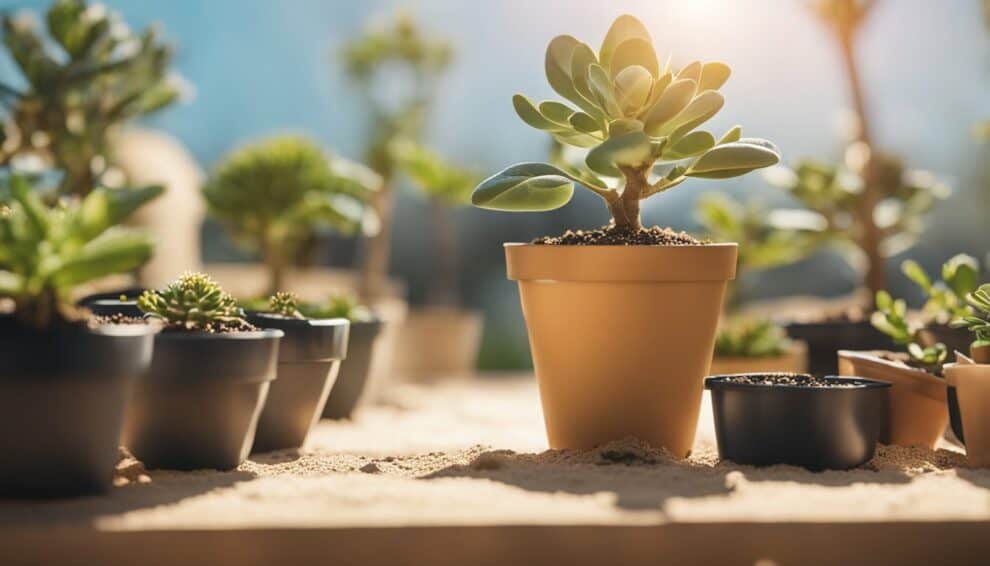Desert Rose, scientifically known as Adenium Obesum, is a succulent plant that is native to East Africa and Arabia.
It is a popular houseplant due to its unique and beautiful appearance, and it is also commonly used in bonsai.
One of the most interesting aspects of desert rose is its ability to be propagated easily, making it a great choice for plant enthusiasts who want to expand their collection.

Propagation of desert rose is a simple and straightforward process that can be done through various methods such as seeds, cuttings, and grafting.
Each method has its own advantages and disadvantages, but the most commonly used method is through cuttings.
With the right conditions and proper care, cuttings can easily root and grow into new plants, making it a cost-effective way to expand your collection.
In this article, we will explore the easy steps to propagate desert rose through cuttings, providing plant enthusiasts with a comprehensive guide to successfully propagate this beautiful plant.
Understanding Adenium Obesum
Species Overview
Adenium obesum, commonly known as desert rose, is a succulent plant native to Africa and Arabia.
It belongs to the family Apocynaceae and is a popular houseplant worldwide due to its attractive flowers and unique appearance.
The plant has a thick, swollen stem that stores water, making it well-suited for arid environments.
Desert roses can grow up to 10 feet tall in their natural habitat, but they are usually much smaller when grown indoors.
The plant produces clusters of fragrant, trumpet-shaped flowers in shades of pink, red, and white, which bloom in the spring and summer.
Growth Habits
Adenium obesum is a slow-growing plant that requires well-draining soil and plenty of sunlight to thrive.
It is also important to avoid overwatering, as the plant is susceptible to root rot.
The plant can be propagated from seeds, cuttings, or grafts. Cuttings are the easiest method of propagation and can be taken from the stem or the root.
It is important to allow the cuttings to dry for a few days before planting them in well-draining soil.
Desert roses are also commonly grown as bonsai trees due to their unique shape and size.
With proper care and maintenance, Adenium obesum can be a beautiful addition to any home or garden.
Propagation Basics

Best Time to Propagate
The best time to propagate desert rose is during the growing season, which is usually from spring to summer.
This is because the plant is actively growing during this time and will be able to recover more quickly from any pruning or cutting.
Required Tools and Materials
Before propagating desert rose, there are a few tools and materials that are required. These include:
- Pruning shears or a sharp knife
- Rooting hormone
- A well-draining soil mix
- A container with drainage holes
It is important to use clean and sharp tools to prevent any damage or infection to the plant.
Rooting hormone helps to encourage root growth, while a well-draining soil mix ensures that the plant does not become waterlogged.
Once the necessary tools and materials are gathered, the next step is to select a healthy stem to propagate.
This stem should be at least 6 inches long and have several leaves.
The stem can then be cut at a 45-degree angle and dipped into rooting hormone before being planted in the soil mix.
By following these basic steps, propagating desert rose can be a simple and rewarding process for any plant enthusiast.
Propagation Methods

Adenium obesum, commonly known as the Desert Rose, can be propagated through two methods: seed propagation and cuttings propagation.
Seed Propagation
Seed propagation is a simple and easy method of propagating Adenium obesum.
The seeds should be collected from the mature pods and should be sown in a well-draining soil mix.
The seeds should be placed in a warm, sunny location and should be watered regularly.
The seedlings will emerge within a few weeks, and once they have grown to a suitable size, they can be transplanted into individual pots.
Cuttings Propagation
Cuttings propagation is a popular method of propagating Adenium obesum as it produces plants that are identical to the parent plant.
The cuttings should be taken from the mature branches and should be allowed to dry for a few days.
Once the cuttings have dried, they should be dipped in rooting hormone and planted in a well-draining soil mix.
The cuttings should be placed in a warm, sunny location and should be watered regularly.
The cuttings will root within a few weeks, and once they have established roots, they can be transplanted into individual pots.
In conclusion, Adenium obesum can be propagated through both seed propagation and cuttings propagation.
Both methods are simple and easy to follow, and with proper care and attention, the plants can grow into beautiful specimens.
Post-Propagation Care

After successfully propagating your desert rose, it is important to take good care of it to ensure its growth and survival.
This section covers the essential aspects of post-propagation care.
Watering and Feeding
Watering is a crucial aspect of caring for your desert rose. It is important to avoid overwatering as it can lead to root rot.
On the other hand, underwatering can cause the plant to wilt and eventually die.
The general rule of thumb is to water your desert rose when the top inch of the soil is dry.
It is also important to use well-draining soil to prevent waterlogging.
Feeding your desert rose is also important to ensure its growth and health. You can use a balanced fertilizer with a ratio of 10-10-10 or 20-20-20.
Fertilize your plant every two weeks during the growing season and reduce the frequency during the dormant season.
Potting and Repotting
Desert roses prefer to be slightly root-bound, so it is not necessary to repot them frequently.
Repotting is only necessary when the plant has outgrown its current container or when the soil has become too compacted.
When repotting, use a well-draining soil mix and a pot that is only slightly larger than the previous one.
Common Challenges
One common challenge when caring for desert roses is pests. Common pests include spider mites, mealybugs, and scale insects.
Regularly inspect your plant for any signs of pests and treat them immediately using an appropriate insecticide.
Another challenge is fungal diseases such as root rot and leaf spot.
To prevent fungal diseases, avoid overwatering and ensure good air circulation around the plant.
If your plant does contract a fungal disease, treat it immediately using a fungicide.
By following these simple post-propagation care steps, you can ensure the healthy growth and survival of your desert rose.
Frequently Asked Questions

What are the necessary conditions for successfully propagating Desert Rose from cuttings?
In order to propagate Desert Rose from cuttings, it is important to choose a healthy and mature plant.
The cutting should be taken from a branch that is at least 6 inches long and has at least two sets of leaves.
The cutting should be allowed to dry for a few days before planting in well-draining soil.
The soil should be kept moist but not waterlogged, and the cutting should be placed in a warm and bright location.
How do you care for Desert Rose seedlings after germination?
After germination, Desert Rose seedlings should be placed in a warm and bright location with well-draining soil.
The soil should be kept moist but not waterlogged. As the seedlings grow, they should be fertilized with a balanced fertilizer every two weeks.
Can you propagate Desert Rose in water, and if so, how?
It is possible to propagate Desert Rose in water, but it is not recommended.
The cutting should be allowed to dry for a few days before planting in well-draining soil.
What is the ideal soil mix for Desert Rose propagation?
The ideal soil mix for Desert Rose propagation is a mixture of sand, perlite, and peat moss.
The soil should be well-draining and kept moist but not waterlogged.
How long does it typically take for Desert Rose cuttings to root?
Desert Rose cuttings typically take 4-6 weeks to root.
During this time, the soil should be kept moist but not waterlogged, and the cutting should be placed in a warm and bright location.
Are there any special techniques for encouraging Desert Rose seeds to germinate?
Desert Rose seeds can be difficult to germinate, but soaking the seeds in warm water for 24 hours before planting can help.
The seeds should be planted in well-draining soil and kept moist but not waterlogged. It can take several weeks for the seeds to germinate.













